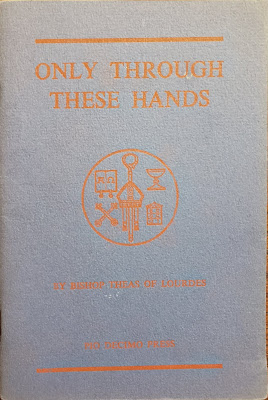Some years ago I got a copy of a small booklet called "Only Through These Hands: A Treatise of the Office of the Bishop in the Catholic Church" by Bishop Pierre-Marie Theas of Lourdes. The booklet was translated from French into English by Geraldine Carrigan who lived until the Feast of St. Joseph, March 19, 2000. The booklet was published by Pio Decimo Press, which is now out of business. It would be wonderful to see this back in print again.
A few days ago, I picked up the copy from my bookshelf again and read through its 32 pages. Despite its small size, "Only Through These Hands" is a succinct yet insightful explanation of the authority, importance, and role of Bishops.
The booklet begins by quoting the Preface used during the Holy Sacrifice of the Mass for the Consecration of Bishop. That traditional Preface with its beautiful symbolism worth repeating. It states in part:
It is truly fitting and just, right and profitable unto salvation that, at all times and in all places, we should give thanks to Thee, O Holy Lord, Father Almighty, Eternal God, source of honor to all dignitaries who in their sacred orders serve Thy glory. Thanks to Thee, O Lord Who, in the privacy of familiar conversation, didst instruct Moses Thy servant, concerning, among other things of divine worship, the nature of sacerdotal garments, and Who didst order that Aaron, Thy chosen one should be clad in mystic robes during sacred functions, so that generation after generation might learn from the example of their forebears, and so that knowledge derived from Thy instruction be not wanting in any age. Among our forebears the very display of symbols would excite reverence; among us, however, the realities themselves mean more than the symbols. Whereas the garb of the ancient priesthood is merely a display for our mind, now the splendor of souls rather than of vestments makes the pontifical glory attractive; because even those things which then were pleasing to the eyes of the flesh had to be grasped by the mind as to their inner meaning. Therefore, we beseech Thee, O Lord, shower upon this Thy servant, whom Thou hast chosen for the ministry of the highest priesthood, this grace, namely, that whatever those garments signify in the lustre of gold, the beauty of jewels, and the varied skill of craftsmanship, may shine forth in their conduct and deeds. Give to thy priests the perfection of ministry, and sanctify them, decked out in ornaments of glory, with the dew of Thy heavenly ointment.
The book is divided into 8 short chapters which each describe the Office of the Bishop:
- According to the Gospels
- According to St. Paul and St. John
- According to St. Ignatius of Antioch
- According to St. Thomas Aquinas
- According to the Pontifical
- According to Leo XIII
- According to Pius XII
- In God's Eyes




















.jpg)


.jpg)







.JPG)
.JPG)
.JPG)
.JPG)
.JPG)
.JPG)
.JPG)
.JPG)
.JPG)

.jpg)





